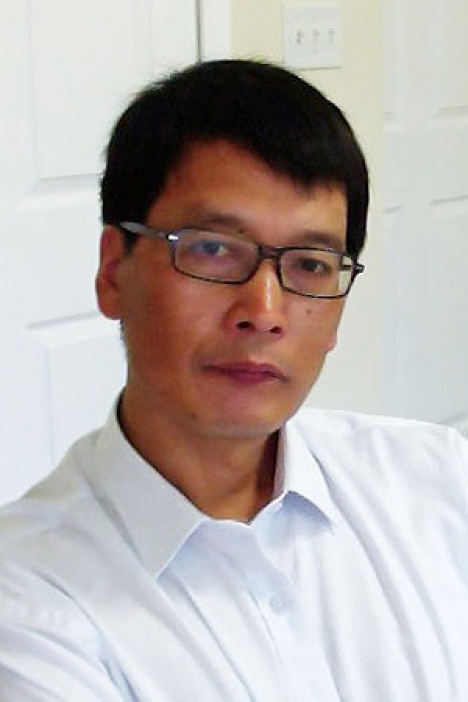Xiang-Jun Lu

Xiang-Jun Lu is a research scientist in the Bussemaker Lab. He received a BS in chemistry and an MS in computational chemistry from Nankai University in Tianjin, China. He obtained his PhD in computational chemistry in 1996 from the University of Sheffield. During his postdoctoral research at Rutgers University (1997-2002), he resolved the long-standing discrepancies among nucleic acid conformational analyses, which led to the establishment of a standard reference frame for the description of nucleic acid base pair geometry. He then developed the 3DNA suite of programs for the analysis, rebuilding, and visualization of three-dimensional nucleic acid structures.
After leaving Rutgers, Dr. Lu worked first as a computational scientist at SAIC Frederick, Maryland (2003-2004), and thereafter as an associate research scientist at the Department of Biological Sciences, Columbia University (2005-present). In Dr. Bussemaker’s laboratory at Columbia, he developed the REDUCE Suite of programs for analyzing gene expressions. Over the years, he has maintained 3DNA—initially as a sideline project, then as a full-time job since September 2011 with the support of an NIH R01 grant (GM096889). Dedicated to the “Continued Development and Maintenance of the 3DNA Suite of Programs,” the grant has enabled him to create DSSR, a new program for defining the secondary structures of RNA from three-dimensional coordinates. Recently, he developed SNAP, another new 3DNA program for the characterization of three-dimensional structures of nucleic acid-protein complexes. 3DNA-related news and information can be found on the 3DNA homepage. Questions and suggestions are always welcome on the 3DNA Forum. Dr. Lu’s research profile can be found at Google Scholar.
PhD, University of Sheffield
Computational Chemistry
MS, Nankai University, Tianjin, China
Computational Chemistry
BS, Nankai University, Tianjin, China
Chemistry
Fazlollahi M, Lee E, Muroff I, Lu XJ, Gomez-Alcala P, Causton HC, Bussemaker HJ. Harnessing natural sequence variation to dissect post-transcriptional regulatory networks in yeast. G3 (Bethesda). 2014 Jun 17.
Lu XJ, Olson WK, Bussemaker HJ. The RNA backbone plays a crucial role in mediating the intrinsic stability of the GpU dinucleotide platform and the GpUpA/GpA miniduplex.Nucleic Acids Res. 2010 Aug;38(14):4868-76.
Boorsma A, Lu XJ, Zakrzewska A, Klis FM, Bussemaker HJ. Inferring condition-specific modulation of transcription factor activity in yeast through regulon-based analysis of genomewide expression.PLoS One. 2008 Sep 3;3(9):e3112.
Moorman C, Sun LV, Wang J, de Wit E, Talhout W, Ward LD, Greil F, Lu XJ, White KP, Bussemaker HJ, van Steensel B. Hotspots of transcription factor colocalization in the genome of Drosophila melanogaster.Proc Natl Acad Sci U S A. 2006 Aug 8;103(32):12027-32.
Halasz G, van Batenburg MF, Perusse J, Hua S, Lu XJ, White KP, Bussemaker HJ. Detecting transcriptionally active regions using genomic tiling arrays.Genome Biol. 2006;7(7):R59.
Lu XJ, Olson WK. 3DNA: a software package for the analysis, rebuilding and visualization of three-dimensional nucleic acid structures. Nucleic Acids Res. 2003 Sep 1;31(17):5108-21.
Olson WK, Bansal M, Burley SK, Dickerson RE, Gerstein M, Harvey SC, Heinemann U, Lu XJ, Neidle S, Shakked Z, Sklenar H, Suzuki M, Tung CS, Westhof E, Wolberger C, Berman HM. A standard reference frame for the description of nucleic acid base-pair geometry. J Mol Biol. 2001 Oct 12;313(1):229-37.
Lu XJ, Shakked Z, Olson WK. A-form conformational motifs in ligand-bound DNA structures.J Mol Biol. 2000 Jul 21;300(4):819-40.
Olson WK, Gorin AA, Lu XJ, Hock LM, Zhurkin VB. DNA sequence-dependent deformability deduced from protein-DNA crystal complexes.Proc Natl Acad Sci U S A. 1998 Sep 15;95(19):11163-8.
Hunter CA, Lu XJ. DNA base-stacking interactions: a comparison of theoretical calculations with oligonucleotide X-ray crystal structures.J Mol Biol. 1997 Feb 7;265(5):603-19.